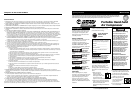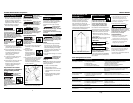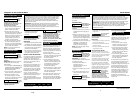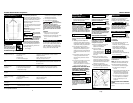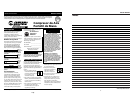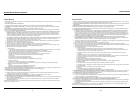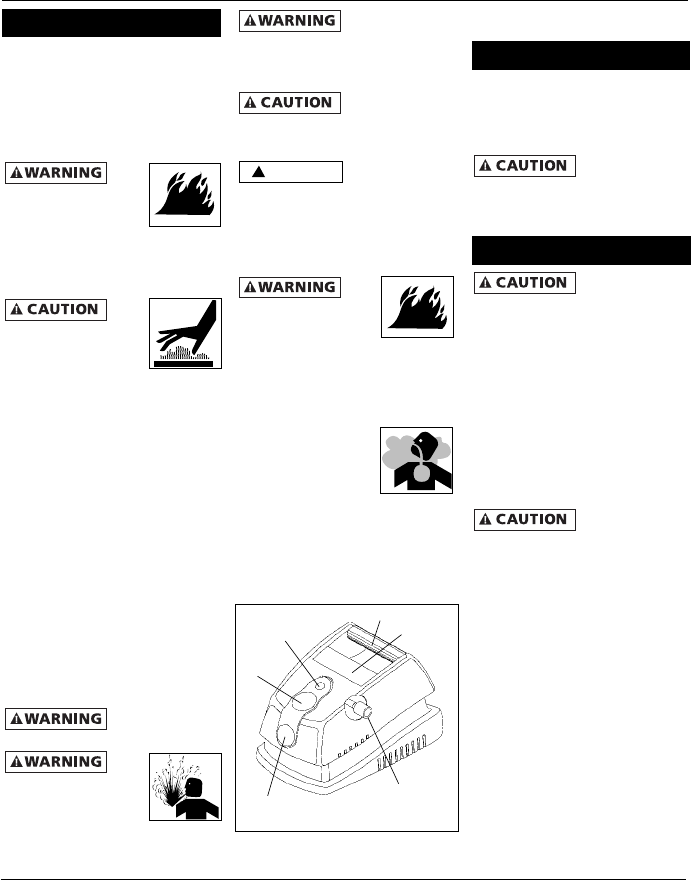
15 Sp
1. Voltaje bajo.
2. Uso Prolongado. Es normal que el
dispositivo térmico apague el
compresor después que lo haya
usado por un peröodo prolongado.
3. Ventilación inadecuada.
4. Alta temperatura ambiental.
Si los
pro-
tectores térmicos se activan, debe
permitir que el motor se enfrie antes de
poder encenderlo. El motor arrancará
automáticamente, sin previo aviso, si la
unidad permaneció conectada al
tomacorrientes y encendida.
ALMACENAMIENTO
1. Mientras no lo esté usando debe
almacenar el compresor y las
mangueras en un sitio seco y frío.
2. Debe desconectar las mangueras y
colgarlas con los extremos hacia
abajo para que se drenen.
Para mayor información en relación al
funcionamiento o reparación de este
producto, comuníquese con el
concesionario de Campbell Hausfeld más
cercano a su domicilio.
!
PRECAUCION
en un tablero, colóquelo en ganchos de
6,4 ó 3,2mm que estén a 10,16cm de
distancia. Al colgarlo a la pared,
cerciórese de que los pernos/clavos
estén exactamente a 10,16cm de
distancia horizontal o el compresor no
cuadrará con los pernos/clavos. El
compresor está diseñado para colgarse
de la cabeza de los clavos/pernos.
Desconecte el cordón
eléctrico del tomacorrientes
y libere toda la presión del sistema
antes de tratar de instalar, darle
servicio, cambiar de lugar o darle
cualquier tipo de mantenimiento.
Este compresor se debe chequear con
frecuencia para ver si tiene algún tipo
de problemas y le debe dar el siguiente
mantenimiento cada vez que lo use.
1. APAGUE el compresor y limpie el
motor, las líneas de aire y los orificios
de ventilación.
IMPORTANTE: Ubique la unidad lo más
lejos posible del área de trabajo.
LUBRICACION
Este
compre-
sor no requiere lubricación.
PROTECTOR TERMICO
Este
compre-
sor está equipado con protectores
térmicos automáticos que apagarán la
unidad si se sobrecalienta.
Si los protectores térmicos APAGAN el
motor frecuentemente, éstas podrían
ser las causas.
!
PRECAUCION
!
AVISO
!
ADVERTENCIA
Mantenimiento
Para Instalarlo en
la Pared (Con’t.)
Modelo FP2004
Guía de diagnóstico de averías
Problema Posible(s) Causa(s) Acción a tomar
1. No hay energía eléctrica
2. Fusible quemado
3. Cortacircuito desconectado
4. Protector(s) térmico desconectado
Fusibles inadecuados, circuito sobrecargado
1. bajo voltaje
2. Ha utilizado el compresor excesivamente
3. Ventilación inadecuada/la temperatura
ambiental es muy alta
El cabezal está dañado
1. Hay fugas de aire en las tuberías o
mangueras (del equipo o el sistema externo)
2. El regulador no está fijado adecuadamente
3. El cabezal está desgastado
Alta humedad
Este compresor no se apaga cuando alcanza
la presión máxima
1. ¿Está conectado? Chequée el fusible/cortacircuito o
protector de sobrecarga del motor
2. Reemplace el fusible quemado
3. Conéctelo, determine la causa del problema
4. Espere a que el motor(s) se enfrie
Chequée si los fusibles son los adecuados, use fusibles de
acción retardada. Desconecte otros artefactos conectados al
mismo circuito o conecte el compresor a un circuito
independiente
1. Chequéelo con un voltimetro
2. Reduzca el tiempo de uso del compresor
3. Reubique el compresor a un área bien ventilada o más fría
Reemplace el compresor
1. Reemplace los componentes dañados o apriételos según sea
necesario
2. Ajuste el regulador
3. Reemplace el compresor
Reubique la unidad a un área menos húmeda; use un filtro en
la línea de aire
No necesita reparación
El compresor no funciona
Los fusibles se queman / el
cortacircuito se activa
El sistema de protección
térmica apaga la unidad
constantemente
Hace mucho ruido o vibra
excesivamente
Expulsa menos aire que
normalmente / la presión
de salida es muy baja
Exceso de humedad en el
aire expulsado
El compresor funciona
continuamente
the instructions provided by the
chemical manufacturer.
It is extremely important to use the
compressor in a clean, well ventilated
area where the surrounding air
temperature will not be more than
100°F.
Do not locate the
compressor air
inlet near steam, paint spray, sandblast
areas or any other source of
contamination. This debris will damage
the motor.
This product is for
use on a nominal
120 volt circuit. Make sure that product
is connected to an outlet having same
configuration as plug.
WIRING
1. Local electrical wiring codes differ
from area to area. Source wiring,
plug and protector must be rated for
at least the amperage and voltage
indicated on motor nameplate, and
meet all electrical codes for this
minimum.
2. Use a slow blow fuse type T or a circuit
breaker.
Overheating, short
circuiting and fire
damage will result from inadequate
wiring, etc.
NOTE: This compressor can be operated
on a 115 volt, 15 amp circuit under the
following conditions:
a. Circuit is not heavily loaded.
b. Voltage supply is normal.
c. Extension cords are of the minimum
gauge specified in this instruction
manual.
d. Circuit is equipped with a 15 amp
circuit breaker or a 15 amp slow
blow fuse type T.
2
Portable Hand-held Air Compressor
7. Before each use, inspect compressed
air system and electrical components
for signs of damage, deterioration,
weakness or leakage. Repair or
replace defective items before using.
8. Check all fasteners at frequent
intervals for proper tightness.
Motors, electrical
equipment and controls
can cause electrical arcs
that will ignite a flammable gas or
vapor. Never operate or repair in or
near a flammable gas or vapor. Never
store flammable liquids or gases in the
vicinity of the compressor.
Compressor parts may be
hot even if the unit is
stopped.
9. Keep fingers away from a running
compressor; fast moving and hot
parts will cause injury and/or burns.
10.If the equipment should start to
abnormally vibrate, switch unit OFF
and check immediately for the
cause. Vibration is generally a
warning of trouble.
11.To reduce fire hazard, keep motor
exterior free of oil, solvent, or
excessive grease.
12.Fast moving air will stir up dust and
debris which may be harmful.
Release air slowly when draining
moisture or depressurizing the
compressor system.
Any misuse of unit could
cause property or equipment
damage and/or personal
injury.
Do not leave the
compressor
unattended while the unit is running.
Never exceed the
recommended pressure
for any inflatable object.
Do not over inflate
objects. Over inflation could cause
property damage and/or personal
injury.
Always put the car
in park; set the
emergency brake; and chock the wheels
before using the compressor or
property damage and/or personal
injury could occur.
Always use a sep-
arate pressure
gauge to check the actual pressure in
tires and in low pressure inflatable
objects.
Do not use
compressor on
high pressure tires used on large
trucks, trailers or tractors. The
compressor is not designed to operate
for the length of time necessary to
inflate these tires.
SPRAYING PRECAUTIONS
Do not spray flammable
materials in vicinity of
open flame or near
ignition sources including the
compressor unit.
13.Do not smoke when spraying paint,
insecticides, or other flammable
substances.
14.Use a face mask/
respirator when
spraying and spray in
a well ventilated area
to prevent health and
fire hazards.
15.Do not direct paint or other sprayed
material at the compressor. Locate
compressor as far away from the
spraying area as possible to
minimize overspray accumulation
on the compressor.
16.When spraying or cleaning with
solvents or toxic chemicals, follow
!
NOTICE
General Safety (Con’t)
Figure 1
Electrical Data
www.campbellhausfeld.com
Air Outlet
Pressure
Regulator
Handle
Storage
Bin
On/Off
Switch
Pressure
Gauge
Location
Funcionamiento
Figura 3 - Vista inferior del compresor
Sitios para instalar la unidad



